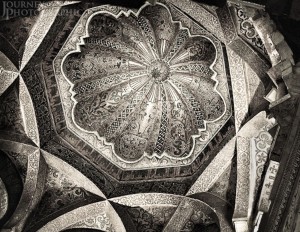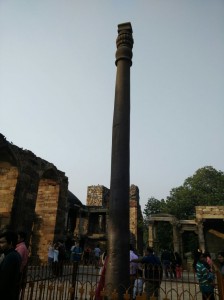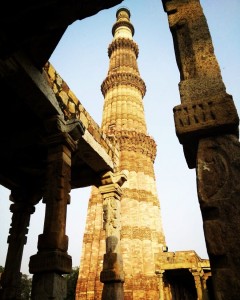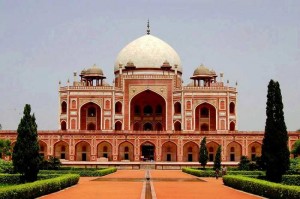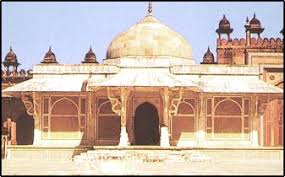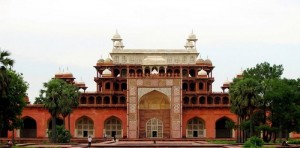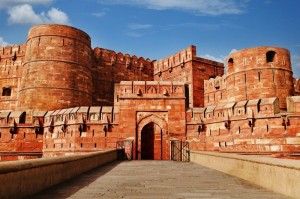Dr. V.K.Maheshwari, M.A. (Socio, Phil) B.Sc. M. Ed, Ph.D.
Former Principal, K.L.D.A.V.(P.G) College, Roorkee, India
India’s architectural heritage constituted ‘the greatest galaxy monuments in the world
Dr. Ernest Binfield Havell (1861-1934)
Dr. Ernest Binfield Havell, insisted that the Islamic architecture in India was influenced by the Hindus. ” Albiruni, the Arab historian, expressed his astonishment at and admiration for the work of Hindu builders. “Our people, he said, “when they see them, wonder at them and are unable to describe them, much less to construct anything like them.”
As the first Islamic monarchy in India, the Slave Dynasty (1206-1290), and all of its successors, the Khalji (1290-1320), the Tughluq (1320-1413), the Sayyid (1414-51), and the Lodi (1451-1526), consistently fixed Delhi as the capital.
The Islamic rule in India saw the introduction of many new elements in the building style also. Art of Delhi Sultanate was the process of absorption and Indianization of the techniques of art and architecture. This was very much distinct from the already prevailing building style adopted in the construction of temples and other secular architecture. The main elements in the Islamic architecture is the introduction of arches and beams, and it is the arcuate style of construction while the traditional Indian building style is tabulate, using pillars and beams and lintels.
Qutb al-Din Aybak , who had subjugated northern India as the general of Muhammad of Gori in Afghanistan, established the first Islamic political regime of the Delhi Sultanate, the Slave Dynasty. He took the fortified town of Qila Rai Pithora, which had been constructed by the Hindu king, Prithvi Raj, settling it as his capital. Aybak dismantled twenty-seven Hindu and Jain temples of to erect the Friday Mosque at the site of a Vishnu temple, reusing their components. The Qutab Mosque in Mehrauli district, which was at the starting point of development, was constructed from the components of dismantled Hindu and Jain temples using Indian traditional methods.
The mosque, later referred to as Quwwat-al-Islam Mosque (meaning Might of Islam), had a narrow oblong worship room with five domes in a row and a large longitudinal courtyard surrounded by cloisters. The succeeding Sultan, Shams al-Din Iltutmish, enlarged it on the left and right sides, to four times its total extent, in 1230. Then, Khalji Sultan, Alah al-Din , enlarged it further to the right and on the opposite side of Kibla to the extent of ten times of the earliest stage.
What is peculiar in this mosque is that an enormous Screen of arches was later erected in front of the worship hall, the existing part of which reaches an impressive height of 15m with a thickness of 2.6m. However, Indian masons did not know the structural system of true arches and domes and constructed the mosque with the pseudo manner of corbelled domes. As a result, a line of twenty domes, which added up to 225m, all collapsed in later years and were carried away as materials for new buildings. One of the earliest mausoleums, Iltutmish Tomb , has also lost its corbelled dome.
Beside the mosque stands a colossal intact Minaret called Qutb Minar, the lower part of which was constructed by Aybak and the upper part by Iltutmish. It was part of a mosque begun at Old Delhi by Kutbu-d Din Aibak; it commemorated the victories of that bloody Sultan over the Hindus, and twenty-seven Hindu temples were dismembered to provide material for the mosque and the tower. It remains the highest tower in India till this day, and its relief-carvings of foliage patterns and Arabic calligraphy are as excellent as those of the Iltutmish Tomb and the Screen of arches.
Ala al-Din commenced constructing the Alai Minar on a twofold scale of the former Minaret in the largest courtyard in the course of the second expansion, but it was not completed, only leaving its basal part. At the new gate erected on this occasion, Alai Darwaza, Indian masons succeeded in erecting a true dome for the first time.
In the oldest courtyard stands an iron pillar 7.5m long (6.8m above ground), which is thought to have been produced by the king of Gupta Dynasty, Chandragupta II, in the 4th century. It was a Stambha (monumental pillar) dedicated to a Vishnu temple according to its inscription, and it seems to have been brought here before the Islamic conquest. This wrought iron pillar, with a Gupta-style capital on the top, is so highly refined that it has not suffered rust at all in spite of its exposure to the elements for 1,600 years.
The mosques from the Khalji onward, having acquired the techniques of Islamic architecture, were fundamentally of the arabian type with the plan of hypostyle oblong hall. Mosques came to be surmounted symbolically with Persian-style domes as the main fashion, and it became the definitive form to arrange three domes continuously on a oblong worship hall, though still in an unrefined manner, such as with the Moth-ki Masjid from the Lodi Dynasty.In general the Sultans of Delhi were too busy with killing to have much time for architecture, and such buildings as they have left us are mostly the tombs that they raised during their own lifetime as reminders that even they would die. The best example of these is the mausoleum of Sher Shah at Sasseram, in Bihar.
It is true that the “Afghan” dynasty used Hindu artisans, copied Hindu themes, and even appropriated the pillars of Hindu temples, for their architectural purposes, and that many mosques were merely Hindu temples rebuilt for Moslem prayer; but this natural imitation passed quickly into a style.
The different religious beliefs are also reflected in the mode of construction and architectural styles. The Islamic style also incorporated many elements from the traditional Indian style and a compound style emanated. The introduction of decorative brackets, balconies, pendentive decorations, etc in the architecture is an example in this regard. The other distinguishing features of Indo-Islamic architecture are the utilisation of kiosks (chhatris), tall towers (minars) and half-domed double portals. As human worship and its representation are not allowed in Islam, the buildings and other edifices are generally decorated richly in geometrical and arabesque designs. These designs were carved on stone in low relief, cut on plaster, painted or inlaid. The use of lime as mortar was also a major element distinct from the traditional building style.
The final triumph of Indian architecture came under the Moguls. The tendency to unite the Mohammedan and the Hindu styles was fostered by the eclectic impartiality of Akbar; and the masterpieces that his artisans built for him wove Indian and Persian methods and motifs into an exquisite harmony symbolizing the frail merger of native and Moslem creeds in Akbar’s synthetic faith.
Islamic architecture was one of rapid capitulation to the superior indigenous art of India. Akbar was not the exception but the classic example. His wholesale adoption of Hindu styles and his patronage of Indian craftsmen marked the end of a brief experiment with non-Indian forms (Tughlak’s tomb for example), and the beginning of one of the greatest periods of purely Indian building.
The first monument of his reign, the tomb erected by him near Delhi for his father The Mausoleum of his father, Humayun, was the first full-blown piece of Mughal architecture, which would determine the splendid style afterward, combining red sandstone and white marble. Its formation is such that in the center of a huge ‘Charbagh’ (four quartered garden) a large square platform is built, on which a mausoleum with identical facades for its four sides stands symbolically and is capped with a large dome of white marble. It was in India among the vast Islamic areas that this form of tomb architecture was especially loved and made great developments, there is a reason for that.
There is also evidence that the building known as Humayun’s Tomb is none other than a captured Lakshmi Temple. Abul Fazal says Humayun is buried in Sirhind. French writer G. Le Bon has published in his book The World of Ancient India (Publisher: Editions Minerva – Spain Date of Publication: 1974) a photo of marble footprints found in the building. He describes them as the footprints of Lord Vishnu. This is typical of a Vedic temple, to have the footprints of the main Divinity of the shrine. In this case, it is the husband of Lakshmi, Lord Vishnu.
As a reflection of this, for buildings in Fatehpur Sikri that he constructed as a new capital and his own mausoleum at Sikandra he seldom used arches and domes and deliberately used traditional posts and beams in spite of being Islamic architecture. A pavilion in Fatehpur Sikri protruding even stone slab eaves protecting against the rainy season looks as it were wooden structure. . A flight of steps leads up to an imposing portal in red sandstone, through whose lordly arch one passes into an enclosure filled with chef-d’oeuvres. The major building is a mosque, but the loveliest of the structures are the three pavilions for the Emperor’s favorite wives, and the marble tomb of his friend, Salim Chisti the sage; here the artists of India began to show that skill in embroidering stone. Historian Vincent Smith in his book Akbar the Great Moghul, says:
” It is surprising to find unmistakable Hindu features in the architecture of the tomb of a most zealous Musalman saint, but the whole structure suggests Hindu feeling and nobody can mistake the Hindu origin of the column and struts of the porch.”
He aggrandized the capital Agra, constructing the Lal Qila (Red Fort) with red sandstone. He also promoted the union of Hindus and Muslims for the stabilization of the empire and applied this principle to architecture too.
As for Akbar’s mausoleum at Sikandra, it became an unprecedented unique Islamic building, posts and beams which were stacked up like a four-storied junglegym as ‘Framework architecture’ on a high-rise platform. Its components are ‘Chatri’ (its etymology is ‘Chatra’ meaning an umbrella in Sanskrit); a turret with an apparently heavy roof supported with four columns. This came to be used as an ornamental element for all sorts of buildings.
Jehangir contributed little to the architectural history of his people.Shah Jehan made his name almost as bright as Akbar’s by his passion for beautiful building. He scattered money as lavishly among his artists.. Like the kings of northern Europe, he imported the surplus artists of Italy, and had them instruct his own carvers in that art of pietra dura (i.e., of inlaying marble with a mosaic of precious stones) which became one of the char- acteristic elements of Indian adornment during his reign.
Shah Jehan was not a very religious soul, but two of the fairest mosques in India rose under his patronage: the Juma Masjid or Friday Mosque at Delhi, and the Moti Masj id or Pearl Mosque at Agra. Both at Delhi and at Agra Jehan built “forts” i.e., groups of royal edifices surrounded by a protective wall.
At Delhi he tore down with superior disdain the pink palaces of Akbar, and replaced them with structures which at their worst are a kind of marble confectionery, and at their best are the purest architectural beauty on the globe. Here is the luxurious Hall of Public Audience, with panels of Florentine mosaic on a black marble ground, and with ceilings, columns and arches carved into stone lacery of frail but incredible beauty. Here, too, is the Hall of Private Audience, whose ceiling is of silver and gold, whose columns are of filigree marble, whose arches are a pointed semicircle composed of smaller flowerlike semicircles, whose Peacock Throne became a legend for the world, and whose wall still bears in precious inlay the proud words of the Moslem poet: “If anywhere on earth there is a Paradise, it is here, it is here, it is here.” The Delhi Fort originally contained fifty-two palaces, but only twenty-seven remain.
The Fort at Agra is in ruins, and we can only guess at its original magnificence. Here, amid many gardens, were the Pearl Mosque, the Gem Mosque, the 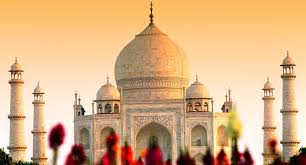 halls of Public and Private Audience, the Throne Palace, the King’s Baths, the Hall of Mirrors, the palaces of Jehangir and of Shah Jehan, the Jasmine Palace of Nur Jehan, and that Jasmine Tower from which the captive emperor, Shah Jehan, looked over the Jumna upon the tomb that he had built for his beloved wife, Mumtaz Mahal.
halls of Public and Private Audience, the Throne Palace, the King’s Baths, the Hall of Mirrors, the palaces of Jehangir and of Shah Jehan, the Jasmine Palace of Nur Jehan, and that Jasmine Tower from which the captive emperor, Shah Jehan, looked over the Jumna upon the tomb that he had built for his beloved wife, Mumtaz Mahal.
All the world knows that tomb by her shortened name as the Taj Mahal. Many an architect has rated it as the most perfect of all buildings standing on the earth today.It is said that three artists designed it: a Persian, Ustad Isa; an Italian, Gieronimo Veroneo; and a Frenchman, Austin dc Bordeaux.
The building is a complex figure of twelve sides, four of which are portals; a slender minaret rises at each corner, and the roof is a massive spired dome. The main entrance, once guarded with solid silver gates, is a maze of marble embroidery; inlaid in the wall in jeweled script are quotations from the Koran, one of which invites the “pure in heart” to enter “the gardens of Paradise.” The interior is simple; and perhaps it is just as well that native and European thieves cooperated in despoiling the tomb of its superabundant jewels, and of the golden railing, encrusted with precious stones, that once enclosed the sarcophagi of Jehan and his Queen. For Aurangzeb replaced the railing with an octagonal screen of almost transparent marble, carved into a miracle of alabaster lace; and it has seemed to some visitors that of all the minor and partial products of human art nothing has ever surpassed the beauty of this screen.
It was a sad error of Shah Jehan’s to make a fortress of these lovely palaces. When the British besieged Agra (1803) they inevitably turned their guns upon the Fort. Seeing the cannon-balls strike the Khass Mahal, or Hall of Private Audience, the Indians surrendered, thinking beauty more precious than victory. A little later Warren Hastings tore up the bath of the palace to present it to George IV; and other portions of the structure were sold by Lord William Bcntinck to help the revenues of India.
Lord William Bentinck, one of the kindliest of the British governoxs of India, once thought of selling the Taj for $150,000 to a Hindu contractor, who believed that better use could be made of the material. Since Lord Curzon’s administration the British Government of India has taken excellent care of these Mogul monuments. just as well that native and European thieves cooperated in despoiling the tomb of its superabundant jewels, and of the golden railing, encrusted with precious stones, that once enclosed the sarcophagi of Jehan and his Queen. For Aurangzeb replaced the railing with an octagonal screen of almost transparent marble, carved into a miracle of alabaster lace; and it has seemed to some visitors that of all the minor and partial products of human art nothing has ever surpassed the beauty of this screen.
The sixth emperor Aurangzeb was a misfortune for Mogul and Indian art. Dedicated fanatically to an exclusive religion, he saw in art nothing but idolatry and vanity. Already Shah Jehan had prohibited the erection of Hindu temples;” Aurangzeb not only continued the ban, but gave so economical a support to Moslem building that it, too, languished under his reign. Indian art followed him to the grave.
Aurangzeb did not like pomp; therefore his tomb in Khurdabad is extremely simple without even a roof. The mighty Badshahi Mosque(1674) in Lahore is the last one among the four great mosques of the Mughals. The mausoleum of Aurangzeb wife, Bibi-ka-Maqbara (1678), was modelled on the Taj Mahal but it can be seen that its size, proportion, and volition for ornamentation were diminishing.
After that, both state power and its art declined; there remains merely the mausoleum of Safdarjang in Delhi , and it would be gradually encroached upon by British colonial culture.
Hindu and Moslem architecture- A comparison
To evaluate Indian architecture in summary and retrospect we find in it two themes, masculine and feminine, Hindu and Mohammedan, about which the structural symphony revolves. As, in the most famous of symphonies, the startling hammer-strokes of the opening bars are shortly followed by a strain of infinite delicacy, so in Indian architecture the over- powering monuments of the Hindu genius at Bodh-Gaya, Bhuvaneshwara, Madura and Tanjore are followed by the grace and melody of the Mogul style at Fathpur-Sikri, Delhi and Agra; and the two themes mingle in a confused elaboration to the end.
It was said of the Moguls that they built like giants and finished liked jewellers; but this epigram might better have been applied to Indian architecture in general: the Hindus built like giants, and the Moguls ended like jewellers.
Hindu architecture impresses us in its mass, Mohammedan architecture in its detail; the first had the sublimity of strength, the other had the perfection of beauty; the Hindus had passion and fertility, the Mohammedan had taste and self-restraint.
The Hindu covered his buildings with such exuberant statuary that one hesitates whether to class them as building or as sculpture; the Mohammedan abominated images, and confined himself to floral or geometrical decoration.
The Hindus were the Gothic sculptor-architects of India’s Middle Ages; the Moslems were the expatriated artists of the exotic Renaissance. All in all, the Hindu style reached greater heights, in proportion as sublimity excels loveliness; on second thought we perceive that Delhi Fort and the Taj Mahal, beside Angkor and Borobudur, are beautiful lyrics beside profound Dramas. One art is the graceful and partial expression of fortunate individuals, the other is the complete and powerful expression of a race.
Hence this little survey must conclude as it began, by confessing that none but a Hindu can quite appreciate the art of India, or write about it forgivably. To a European this popular art of profuse ornament and wild complexity will seem at times almost primitive and barbarous. Only a native believer can feel the majesty of the Hindu temples, for these were built to give not merely a form to beauty but a stimulus to piety and a pedestal to faith.
It is in these terms all Indian civilization as the expression of a “medieval” people to whom religion is profounder than science. In this piety lie the weakness and the strength of the Hindu: his superstition and his gentleness, his introversion and his insight, his backwardness and his depth, his weakness in war and his achievement in art. Doubtless his climate affected his religion, and cooperated with it to enfeeble him; therefore he yielded with fatalistic resignation to the Aryans, the Huns, the Moslems and the Europeans. History punished him for neglecting science. The old civilization of India is finished. It began to die when the British came.
References
- CANDEE, HELEN: Angkor the Magnificent. New York, 1924
- CHIROL, SIR VALENTINE: India. London, 1926.
- GANGOLY, O. C.: Indian Architecture. Calcutta, n.d.
- GANGOLY, O. C.: Art of Java. Calcutta, n.d.
- HAVELL, E. B.: Ancient and Medieval Architecture of India. London, 1915.
- HAVELL, E. B.: Ideals of Indian Art. New York, 1920.
- HAVELL, E. B.: History of Aryan Rule in India. Harrap, London, n.d.
- FRAZER, R. W.: Literary History of India. London, 1920.
- FISCHER, OTTO: Die Kunst Indiens, Chinas und Japans. Berlin, 1928.
- FERGUSON, J. G: Outlines of Chinese Art. University of Chicago, 1919.
- FRGUSSON, JAS.: History of Indian and Eastern Architecture, 2V. London, 1910.
- FERGUSSON, JAS.: History of Architecture in All Countries. 2V. London, 1874.
- LORENZ, D. E.: The ‘Round the World Traveler. New York, 1927.
- SMITH, A. H.: Chinese Characteristics. New York, 1894.
- SMITH, G. ELLIOT: Human History. New York, 1929.
- SMITH, W. ROBERTSON: The Religion of the Semites. New York, 1889.
- SMiTH,V. A.: Asoka. Oxford, 1920.
- Will Durant: Our Oriental Heritage. Simon and Schuster. New York 1954

